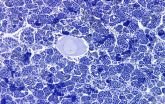(Press-News.org) Tracking the rotation speed of solid planets, like the Earth and Mars, is a relatively simple task: Just measure the time it takes for a surface feature to roll into view again. But giant gas planets Jupiter and Saturn are more problematic for planetary scientists, as they both lack measureable solid surfaces and are covered by thick layers of clouds, foiling direct visual measurements by space probes. Saturn has presented an even greater challenge to scientists, as different parts of this sweltering ball of hydrogen and helium are known to rotate at different speeds, whereas its rotation axis and magnetic pole are aligned.
A new method devised by Tel Aviv University researcher Dr. Ravit Helled, published recently in Nature, proposes a new determination of Saturn's rotation period and offers insight into the internal structure of the planet, its weather patterns, and the way it formed. The method, by Dr. Helled of the Department of Geosciences at TAU's Raymond and Beverly Sackler Faculty of Exact Sciences and Drs. Eli Galanti and Yohai Kaspi of the Department of Earth and Planetary Sciences at the Weizmann Institute of Science, is based on Saturn's measured gravitational field and the unique fact that its east-west axis is shorter than its north-south axis.
According to the new method, Saturn's day is 10 hours, 32 minutes and 44 seconds long. When the researchers applied their method to Jupiter, whose rotation period is already well known, the results were identical to the conventional measurement, reflecting the consistency and accuracy of the method.
Between sunup and sundown on Saturn
For years, scientists have had difficulty coming up with a precise measurement of Saturn's rotation. "In the last two decades, the standard rotation period of Saturn was accepted as that measured by Voyager 2 in the 1980s: 10 hours, 39 minutes, and 22 seconds," said Dr. Helled. "But when the Cassini spacecraft arrived at Saturn 30 years later, the rotation period was measured as eight minutes longer. It was then understood that Saturn's rotation period could not be inferred from the fluctuations in radio radiation measurements linked to Saturn's magnetic field, and was in fact still unknown." The Cassini spacecraft had measured a signal linked to Saturn's magnetic field with a periodicity of 10 hours, 47 minutes and 6 seconds long -- slower than previous recordings.
"Since then, there has been this big open question concerning Saturn's rotation period," said Dr. Helled. "In the last few years, there have been different theoretical attempts to pin down an answer. We came up with an answer based on the shape and gravitational field of the planet. We were able to look at the big picture, and harness the physical properties of the planet to determine its rotational period."
Helled's method is based on a statistical optimization method that involved several solutions. First, the solutions had to reproduce Saturn's observed properties (within their uncertainties): its mass and gravitational field. Then the researchers harnessed this information to search for the rotation period on which the most solutions converged.
Narrowing the margin of error
The derived mass of the planet's core and the mass of the heavy elements that make up its composition, such as rocks and water, are affected by the rotation period of the planet.
"We cannot fully understand Saturn's internal structure without an accurate determination of its rotation period," said Dr. Helled. Knowledge of Saturn's composition provides information on giant planet formation in general and on the physical and chemical properties of the solar nebula from which the solar system was formed.
"The rotation period of a giant planet is a fundamental physical property, and its value affects many aspects of the physics of these planets, including their interior structure and atmospheric dynamics," said Dr. Helled. "We were determined to make as few assumptions as possible to get the rotational period. If you improve your measurement of Saturn's gravitational field, you narrow the error margin."
The researchers hope to apply their method to other gaseous planets in the solar system such as Uranus and Neptune. Their new technique could also be applied in the future to study gaseous planets orbiting other stars.
INFORMATION:
American Friends of Tel Aviv University supports Israel's most influential, most comprehensive and most sought-after center of higher learning, Tel Aviv University (TAU). US News & World Report's Best Global Universities Rankings rate TAU as #148 in the world, and the Times Higher Education World University Rankings rank TAU Israel's top university. It is one of a handful of elite international universities rated as the best producers of successful startups, and TAU alumni rank #9 in the world for the amount of American venture capital they attract.
A leader in the pan-disciplinary approach to education, TAU is internationally recognized for the scope and groundbreaking nature of its research and scholarship -- attracting world-class faculty and consistently producing cutting-edge work with profound implications for the future.
(New York - March 25, 2015) Induced pluripotent stem cells (iPSCs) -- adult cells reprogrammed back to an embryonic stem cell-like state--may better model the genetic contributions to each patient's particular disease. In a process called cellular reprogramming, researchers at Icahn School of Medicine at Mount Sinai have taken mature blood cells from patients with myelodysplastic syndrome (MDS) and reprogrammed them back into iPSCs to study the genetic origins of this rare blood cancer. The results appear in an upcoming issue of Nature Biotechnology.
In MDS, genetic mutations ...
CORVALLIS, Ore. - Deep-water marine fish living on the continental slopes at depths from 2,000 feet to one mile have liver pathologies, tumors and other health problems that may be linked to human-caused pollution, one of the first studies of its type has found.
The research, conducted in the Bay of Biscay west of France, also discovered the first case of a deep water fish species with an "intersex" condition, a blend of male and female sex organs. The sampling was done in an area with no apparent point-source pollution, and appears to reflect general ocean conditions.
The ...
DURHAM, N.C. -- The value of many oceanfront properties on the East Coast could drop dramatically if Congress were to suddenly end federal beach nourishment subsidies, a new study by researchers at three universities finds.
In beach nourishment, new sand, often dredged from nearby inlets or the offshore sea floor, is added to an eroding beach to widen it and help prevent future erosion.
"The expectation that the federal government will continue to provide subsidies for erosion-control measures has significantly inflated property values in many coastal communities," ...
Would-be participants of higher education must be given full and transparent advice before they accumulate debts as students that follow them into the workplace, according to a report published in the International Journal of Pluralism and Economics Education.
Deborah Figart of the School of Education, at The Richard Stockton College of New Jersey in Galloway, says that there is a dearth of pre-loan and post-loan counseling for undergraduate students using student loans to help finance their higher education. She has devised an assignment that can be adapted to a wide ...
A new paper to be published in the journal Zootaxa (April 6, 2015) describes 30 new insect species in a single genus, Megaselia, of the fly family Phoridae. Describing 30 species in a single paper is rare, but what's especially striking is that all these come from urban Los Angeles.
The discoveries come from researchers in the BioSCAN project (Biodiversity Science: City and Nature) at the Natural History Museum of Los Angeles County (NHM). The BioSCAN project is a three year investigation of patterns of biodiversity in and around urban Los Angeles, based on sampling ...
AUBURN, AL - In the production of organic vegetables, nitrogen is important, yet can be quite costly to manage. Nitrogen management is even more challenging when production practices call for the use of polyethylene mulch combined with fertigation. The authors of a new study published in HortScience have found that hydrolyzed fish fertilizer holds promise as an "economically feasible" nitrogen source for growing organic vegetables.
"Soluble organic nitrogen sources suitable for fertigation in organic vegetable production are much needed," said lead author of the study, ...
(SACRAMENTO, Calif.) -- In an editorial posted online today in the Annals of Emergency Medicine, two practicing emergency medicine physicians from the University of California, Davis, and Brown University -- both thought leaders at the forefront of finding solutions to the public health crisis of gun violence -- urge their colleagues to take direct action to protect the health and safety of patients and communities.
Their editorial follows the Feb. 24 call to action by eight health professional organizations, including the American College of Emergency Physicians, and ...
In the year since the World Health Organization (WHO) was first notified of an outbreak of what proved to be Ebola virus disease in the west African country of Guinea, more than 24,000 cases have been reported and over 10,000 individuals have died - primarily in Guinea, Liberia and Sierra Leone. Moreover, countless non-Ebola deaths have occurred as a result of the closing of health systems in those countries, and an international aid effort has invested billions of dollars in control efforts.
In a paper published in the open-access journal PLOS Medicine, experts in ...
NASA-NOAA's Suomi NPP satellite captured an image of the remnants of Tropical Cyclone Nathan over the southern Top End of Australia's Northern Territory on March 25.
On March 25, the Australian Bureau of Meteorology (ABM) issued a Severe Weather Warning for heavy rainfall for people in the Daly, Arnhem, Carpentaria and Gregory forecast districts of Top End. The Top End contains the region's capital city of Darwin, and is home to Kakadu National Park, the country's largest national park. For updated watches and warnings, visit: http://www.bom.gov.au/cyclone/.
When Suomi ...
Getting a good education may not improve your life chances of happiness, according to new mental health research from the University of Warwick.
In a new study published in the British Journal of Psychiatry, researchers from Warwick Medical School examined socioeconomic factors related to high mental wellbeing, such as level of education and personal finances.
Low educational attainment is strongly associated with mental illness but the research team wanted to find out if higher educational attainment is linked with mental wellbeing.
The team found all levels of ...


